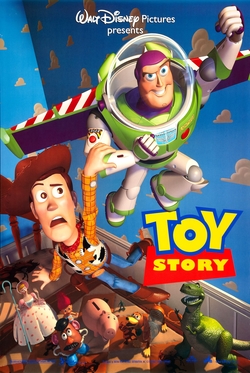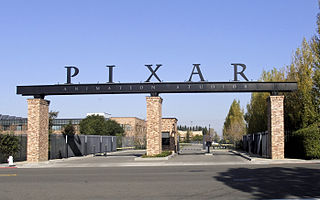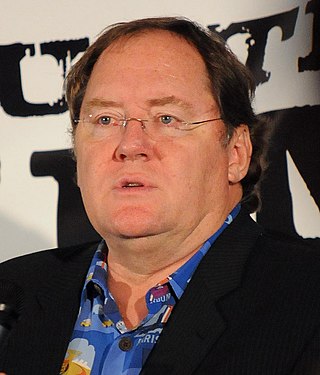Related Research Articles

Toy Story is a 1995 American animated comedy film produced by Pixar Animation Studios for Walt Disney Pictures. The first installment in the franchise of the same name, it was the first entirely computer-animated feature film, as well as the first feature film from Pixar. It was directed by John Lasseter and produced by Bonnie Arnold and Ralph Guggenheim, from a screenplay written by Joss Whedon, Andrew Stanton, Joel Cohen, and Alec Sokolow and a story by Lasseter, Stanton, Pete Docter, and Joe Ranft. The film features music by Randy Newman, and was executive-produced by Steve Jobs and Edwin Catmull. The film features the voices of Tom Hanks, Tim Allen, Don Rickles, Jim Varney, Wallace Shawn, John Ratzenberger, Annie Potts, R. Lee Ermey, John Morris, Laurie Metcalf, and Erik von Detten.

Pixar Animation Studios is an American animation studio based in Emeryville, California, known for its critically and commercially successful computer-animated feature films. Since 2006, Pixar has been a subsidiary of Walt Disney Studios, a division of the Disney Entertainment division of the Walt Disney Company.

Toy Story 2 is a 1999 American animated film produced by Pixar Animation Studios for Walt Disney Pictures. The second installment in the Toy Story franchise and the sequel to Toy Story (1995), it was directed by John Lasseter and co-directed by Ash Brannon and Lee Unkrich, from a screenplay written by Andrew Stanton, Rita Hsiao, Doug Chamberlin, and Chris Webb, from a story conceived by Lasseter, Stanton, Brannon, and Pete Docter. In the film, Woody is stolen by a toy collector, prompting Buzz Lightyear and his friends to rescue him, but Woody is then tempted by the idea of immortality in a museum. Tom Hanks, Tim Allen, Don Rickles, Jim Varney, Wallace Shawn, John Ratzenberger, Annie Potts, R. Lee Ermey, John Morris, and Laurie Metcalf reprise their roles from the first Toy Story film and they are joined by Joan Cusack, Kelsey Grammer, Estelle Harris, Wayne Knight, and Jodi Benson, who play the new characters introduced in this film. This is the last Toy Story film to feature Varney as the voice of Slinky Dog before his death the following year.

Tin Toy is a 1988 American computer-animated short film produced by Pixar and directed by John Lasseter. The short film, which runs for five minutes, stars Tinny, a tin one-man band toy, trying to escape from Billy, a human baby. The third short film produced by the company's small animation division, it was a risky investment: due to the low revenue produced by Pixar's main product, the Pixar Image Computer, the company was under financial constraints.

Knick Knack is a 1989 American computer-animated short film produced by Pixar that was written and directed by John Lasseter. The short is about a snow globe snowman who wants to join the other travel souvenirs in a summer-themed party. However, the glass dome that surrounds him prevents him from doing so, thus leading to his many tries to break out of his snow globe. Knick Knack is Pixar's fourth short and the final short produced during the company's tenure as a hardware company.

Luxo Jr. is a 1986 American computer-animated short film produced and released by Pixar. Written and directed by John Lasseter, the two-minute short film revolves around one larger and one smaller desk lamp. The larger lamp, named Luxo Sr., looks on while the smaller, "younger" Luxo Jr. plays exuberantly with a ball to the extent that it accidentally deflates. Luxo Jr. was Pixar's first animation after Ed Catmull and John Lasseter left Industrial Light & Magic's computer division of Cinetron Computer Systems. The film is the source of Luxo Jr., the mascot of Pixar.

Geri's Game is a 1997 American computer-animated short film produced by Pixar and written and directed by Jan Pinkava. The short, which shows an elderly man named Geri who competes with himself in a game of chess, was Pixar's first film to feature a human being as its main character; Geri later made a cameo appearance in Toy Story 2 as "The Cleaner", here voiced by Jonathan Harris instead of Bob Peterson.

John Alan Lasseter is an American film director, producer, and animator. He has served as the Head of Animation at Skydance Animation since 2019. Previously, he acted as the chief creative officer of Pixar Animation Studios, Walt Disney Animation Studios, and Disneytoon Studios, as well as the Principal Creative Advisor for Walt Disney Imagineering.

Red's Dream is a 1987 American animated short film written and directed by John Lasseter and produced by Pixar. The short film, which runs four minutes, stars Red, a unicycle. Propped up in the corner of a bicycle store on a rainy night, Red dreams of a fantasy where it becomes the star of a circus. Red's Dream was Pixar's second computer-animated short following Luxo Jr. in 1986, also directed by Lasseter.

The Adventures of André & Wally B. is a 1984 American animated short film produced by the Lucasfilm Computer Graphics Project, a division of Lucasfilm and the predecessor of Pixar. The short was groundbreaking by the standards of the time and helped spark the film industry's interest in computer animation.
David W. Allen was an American film and television stop motion model (puppet) animator.
Gary Roger Rydstrom is an American sound designer and film director. He has been nominated for 20 Academy Awards for his work in sound for movies, winning 7.
Tiny Toy Stories is a home video compilation of five computer-animated short films made by Pixar. It was released on October 29, 1996, by Walt Disney Home Video and Disney Videos internationally. The International releases, including the UK and Japan, have the Toy Story characters hosting it and talking about the shorts. Additionally, the international releases have Knick Knack and Tin Toy switched, to exemplify how "without Tin Toy, there would've been no Toy Story".

William "Bill" Reeves is a Canadian animator and technical director known for working with John Lasseter on the animated shorts Luxo Jr. and The Adventures of André and Wally B.
James Ford Murphy is an American animator. He is the head of animation at Pixar Animation Studios. He directed the 2014 short film Lava.
Beach Chair is a short computer animation test clip created by animator Eben Ostby for Pixar in 1986. It depicts a chair walking across the sand, dipping its leg into the water, and then moving along. Ostby made the project with the feedback of John Lasseter to work out details of rendering software.

Luxo Jr. is a semi-anthropomorphic toy desk lamp character used as the primary mascot of Pixar Animation Studios. He is the protagonist of the short film of the same name and appears on the production logo of every Pixar film, hopping into view and jumping on the capital letter "I" in "PIXAR" to flatten it. John Lasseter created the character, modeling it after his own Luxo brand lamp. In 2009, the manufacturer of Luxo lamps sued Disney, the parent company of Pixar, for selling Luxo Jr.-branded merchandise.
David Salesin is an American computer scientist. He has worked in computer graphics, three-dimensional and four-dimensional mathematics, and photorealistic rendering. Until 2019, he was the Director of Snap Inc. Research Team, an affiliate professor in the Department of Computer Science & Engineering of the University of Washington in Seattle, and previously director of the Adobe Creative Technologies Lab. He is currently a Principal Scientist at Google.

Sharon Calahan is an American cinematographer who was director of photography on the Pixar films A Bug's Life (1998), Toy Story 2 (1999), and Finding Nemo (2003), and was lighting director for Ratatouille (2007), Cars 2 (2011), and The Good Dinosaur (2015). She took part in the early rise of computer animated feature filmmaking and the acceptance of that medium as cinematography. Calahan is the first member of the American Society of Cinematographers who was invited to join on the basis of a career entirely in animated film. She was nominated, with Bill Reeves, Eben Ostby, and Rick Sayre, for a 2000 BAFTA Award for Best Achievement in Special Visual Effects for A Bug's Life.
References
- ↑ Van Develder, Julia (Fall 2010). "Doing the Math". Vassar. Vol. 106, no. 3. Retrieved November 20, 2015.
- ↑ Linzmayer, Owen W. (2004). Apple Confidential 2.0. San Francisco: William Pollock. p. 217. ISBN 1593270100.
- ↑ Paik, Karen (2007). To Infinity and Beyond!: The Story of Pixar Animation Studios. San Francisco: Chronicle Books LLC. ISBN 978-0811850124.
- ↑ "Eben Ostby". IMDb. Retrieved November 20, 2015.